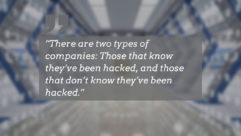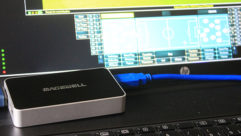DEFENSIVE STRATEGIES
Oct 1, 2001 12:00 PM,
STEVE FILIPPINI
SECURITY SYSTEMS ARE DESIGNED TO PROTECT lives and property. They hide in metal enclosures and stretch out to all points of your home and business through thin, insulated wires. These wires are terminated with magnetic contacts and electronic sensing devices that pick up body heat and motion, among other things.
The brain of the security system branches off to a small device known as the keypad. From there, most of the system’s functions can be invoked and executed. The security system’s communication link to the responding authorities relies on secured cable connections to a telephone line or radio frequency network. Although this may sound like a fragile array of components, security systems are built tough and designed to last.
They have to be, since security systems often reside in hostile environments. They are there because your commercial customer is concerned about the welfare of their customers, employees and inventory. They are there because homeowners want to protect family and friends from harm and loss. Since this is the role the system plays, it is a target to outside elements; it is your job to protect your security system from harm.
LIKE A BRAIN IN A HARD SKULL
Let’s start with the main control panel. A circuit board with hundreds of tiny components that can be snapped in half like a graham cracker needs ample protection. That protection comes in the form of a metal enclosure with a lock on the door to keep out unauthorized personnel. This in itself is not enough. The location you select for the enclosure is just as important as its durability. In a residence, the master bedroom closet is usually where the panel is located. Parents instruct the family to stay away from the closet, but for some reason they tend to leave the key for the enclosure sitting in the lock. In a commercial application, the control panel is usually kept behind a locked, reinforced door. The door to enter the room is contacted and sometimes backed up with a motion sensor. In some installations, the low-voltage transformers used to power the system are covered up with a metal plate and secured to the wall. This helps to avoid accidental (and sometimes intentional) unplugging and removal of the power source.
Typically, the fortress you have selected will protect the main control panel, power source and communication feeds to the system. Once you leave the room with low-voltage cables and devices, it’s open season on your system.
KEYPADS ARE TARGETS
System keypads are always targets. People tend to believe that disabling the keypad disables the rest of the system. Not true. Security systems use the keypad as an extension for user interface purposes. Even if the keypad is wiped off the wall with a sledgehammer or the power leads are shorted, an independent fuse will blow, leaving the rest of the system operational. The only things disabled will be the audible and visual alerts.
Still, it’s a good idea to safeguard against keypad vandalism. Locating the device in the middle of a showroom or near a public restroom is never a good idea. People are prone to push buttons and poke at the display to see if they can make it blink or beep. Some people will enter their ATM number to see if the system will light up and dance for them. Aside from wearing away the button markings, harm is minimal…unless your access code happens to match someone’s PIN and you get a visit from the local authorities. Locate the keypad away from the public to avoid tampering. You may even notice that some stores keep their keypads behind a locked, clear plastic enclosure. You can see it, you can hear it, but you can’t touch it.
DOOR CONTACTS
Door contacts take the brunt of security system abuse. Early on in my career, it was common to mount the contacts on the outside of the doorframe. Looping a wire from contact to contact before scaling the wall was also the norm. Eventually, we learned this was not a smart idea. Window washers, painters, interior decorators and the general public created enough service calls to last me a lifetime. The door contacts needed to be hidden. Recessed switches live inside the doorjamb and frames and now have stronger magnets to continue the closed-circuit requirements. The contact’s wiring is now snaked inside doorframes with lightweight metal conduit covering up any exposed runs. Hiding the wires is good for several reasons. The most important reason is that when they are exposed, people tend to tug on them just to see where they go. Some merchants will even hang Christmas ornaments on them if they happen to be in the right location, a definite ho-ho-ho no-no-no.
Destruction, as you can see, is not always intentional. When installing contacts for roll-up doors during my first few years, I always pulled out the masonry drill bit and secured the contacts onto the concrete floor at the base of the door. I even once tried to use a RAMSET (a nifty tool that uses gunpowder-packed cartridges to blast nails into concrete surfaces) to mount the contact. With the theme of the Rifleman TV series floating in my head, I drew a bead on the contact and pulled the trigger. I shattered the contact and bounced the nail off the wall and into a display of light bulbs. I never attempted that again.
Anyway, once the floor-mounted contacts were installed, they became targets for forklift drivers and were pried from their intended locations. I have since learned to mount the contacts at the top of the door for safekeeping. Another reason to locate the contact at the top of the door is to protect the magnet on the door. Normally, a bracket is needed to extend the magnet out so it can rest squarely over the contact. Employees looked at the brackets as new foot rests to use while lowering the doors. Even though the contacts are encased in a strong metal shell, they still take abuse and break under the right conditions. Make sure you don’t place contacts under those conditions.
WIRE WEAR
Wires exposed in commercial applications are prone to damage from everyday activity in the workplace. From forklifts (a sworn enemy of the security system), to stock that shifts against the walls, to people who need to end their day by cutting something important: Wires are easily damaged if not protected properly. Some applications require metal conduit sticks to cover the wire runs from a height of 10 feet to the door or window contacts below. Other applications use an expensive, metal-clad wire. This type of cable is impervious to moisture and has a lead sheath under the metal covering. It can also be directly buried in applications where conduit is normally used. Other cable types include plenum, which carries a higher resistance to fire and has an abrasive, resistant covering. These super cables are typically used in commercial applications and are not required for the standard residential installation. It’s just nice to know they are out there if you ever need them.
How do you secure a device to the wall or attach a safeguarded cover? One way to avoid tampering is to use tamperproof screws. These neat (and sometimes frustrating) security devices can theoretically only be used once because the head of the screw only allows a clockwise operation (righty-tighty, lefty-loosey). This means you need to be very sure about when and where you use them. Even so, if you happen to make a mistake and need to remove the screw, there is a tool designed to do just that. That’s great news, especially for someone like me who always manages to find a way to incorrectly mount something. One company that provides this type of removal tool is the Tamper-Proof Screw Company, online at www.tamperproof.com.
BELLS AND HORNS
External bells and horns are always targets to outside evils. Audible devices are used to alert neighbors and the responding agencies to a problem that needs their attention. Since these items are exposed to the elements all the time, a rustproof, sturdy enclosure is recommended. There are even some enclosures rated to withstand explosions and stop bullets from penetrating them, but if someone is desperate enough to use firearms on a bell box, I say let them take what they want, and let the authorities go after the felons.
External enclosures come equipped with tamper switches that detect removal from the wall and removal of the front cover. Old bell boxes used the bolt that held the cover on as the component that kept the tamper plunger depressed. The tamper switches of yesteryear were mechanical in operation. Inside the tamper casing, two metal strips lined each side of the switch. The plunger was spring-loaded with a metal strip extending from each side of it. As the plunger was depressed, the moving strip of metal came in contact with the strips on the side and a closed-circuit connection was achieved. As time went on, the internal metal strips oxidized and became less conductive, causing false alarms and systems that could not be armed at night. Some tamper switches are now glass-encased and reed-like in design. Since the air cannot get to the circuit’s contacts, the contacts’ life span increases tenfold. Still, the plunger contact remains out there with industry improvements making it a reliable device to use.
THE BEST DEFENSE
Even after you’ve taken all the steps necessary to prevent system component damage, there is always someone out there specifically targeting the security device. This is where camouflage comes in handy. There are several ways to cover up the appearance of a camera, for example. At first, these ideas seem a bit far-fetched and unnecessary, but they are very effective. Today’s camera lenses are so small, they can be routed and buried almost anywhere. Cameras can be hidden behind the face of a clock or a work of art. My only complaint is that the people who design the front face of these items should use a little more imagination; I have seen some drab models lately. One neat camera-lens disguise that recently caught my eye is the phony sprinkler head and smoke detector. You have to get up really close to notice it, and that’s what makes the disguise so great.
You should look at trade magazines that advertise security devices. Magazines and Internet searches yield an abundance of products designed to protect and conceal your system from harm.
Steve Filippini is a senior security technician with 20 years of experience in the security installation industry. He can be reached at [email protected].









